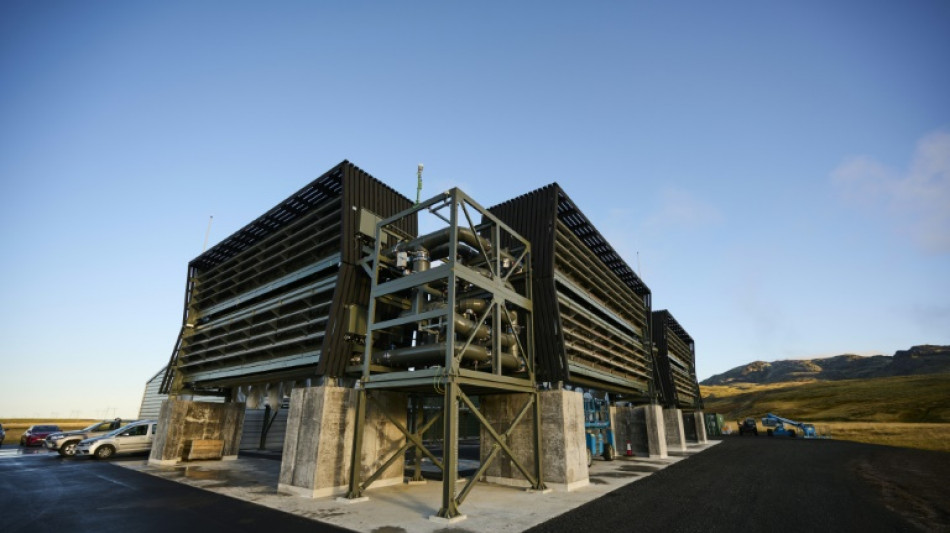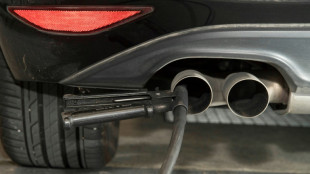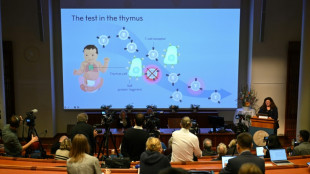
-
 Unreachable Nobel winner hiking 'off the grid'
Unreachable Nobel winner hiking 'off the grid'
-
Retirement or marketing gimmick? Cryptic LeBron video sets Internet buzzing

-
 CAF 'absolutely confident' AFCON will go ahead in protest-hit Morocco
CAF 'absolutely confident' AFCON will go ahead in protest-hit Morocco
-
Paris stocks slide amid French political upheaval, Tokyo soars

-
 EU should scrap ban on new combustion-engine sales: Merz
EU should scrap ban on new combustion-engine sales: Merz
-
US government shutdown enters second week, no end in sight

-
 World MotoGP champion Marquez to miss two races with fracture
World MotoGP champion Marquez to miss two races with fracture
-
Matthieu Blazy reaches for the stars in Chanel debut

-
 Macron gives outgoing French PM final chance to salvage government
Macron gives outgoing French PM final chance to salvage government
-
Illinois sues to block National Guard deployment in Chicago

-
 Exiled Willis succeeds Dupont as Top 14 player of the season
Exiled Willis succeeds Dupont as Top 14 player of the season
-
Hamas and Israel open talks in Egypt under Trump's Gaza peace plan

-
 Mbappe undergoing treatment for 'small niggle' at France camp: Deschamps
Mbappe undergoing treatment for 'small niggle' at France camp: Deschamps
-
Common inhalers carry heavy climate cost, study finds

-
 Madagascar president taps general for PM in bid to defuse protests
Madagascar president taps general for PM in bid to defuse protests
-
UEFA 'reluctantly' approves European league games in US, Australia

-
 Hundreds protest in Madagascar as president to announce new premier
Hundreds protest in Madagascar as president to announce new premier
-
Greta Thunberg lands in Greece among Gaza flotilla activists deported from Israel

-
 UNESCO board backs Egyptian ex-minister for top job: official
UNESCO board backs Egyptian ex-minister for top job: official
-
Facing confidence vote, EU chief calls for unity

-
 Cash-strapped UNHCR shed 5,000 jobs this year
Cash-strapped UNHCR shed 5,000 jobs this year
-
Mbappe to have 'small niggle' examined at France camp: Deschamps

-
 Brazil's Lula asks Trump to remove tariffs in 'friendly' phone call
Brazil's Lula asks Trump to remove tariffs in 'friendly' phone call
-
'Terrible' Zverev dumped out of Shanghai by France's Rinderknech

-
 What are regulatory T-cells? Nobel-winning science explained
What are regulatory T-cells? Nobel-winning science explained
-
OpenAI signs multi-billion dollar chip deal with AMD

-
 Salah under fire as Liverpool star loses his spark
Salah under fire as Liverpool star loses his spark
-
Paris stocks drop as French PM resigns, Tokyo soars

-
 ICC finds Sudan militia chief guilty of crimes against humanity
ICC finds Sudan militia chief guilty of crimes against humanity
-
Zverev dumped out of Shanghai Masters by France's Rinderknech

-
 One hiker dead, hundreds rescued after heavy snowfall in China
One hiker dead, hundreds rescued after heavy snowfall in China
-
Hundreds stage fresh anti-government protests in Madagascar

-
 Feminist icon Gisele Pelicot back in court as man appeals rape conviction
Feminist icon Gisele Pelicot back in court as man appeals rape conviction
-
US government shutdown enters second week

-
 Kasatkina ends WTA season early after hitting 'breaking point'
Kasatkina ends WTA season early after hitting 'breaking point'
-
Paris stocks drop as French PM resigns

-
 Death toll from Indonesia school collapse rises to 63
Death toll from Indonesia school collapse rises to 63
-
Medicine Nobel to trio who identified immune system's 'security guards'

-
 UN rights council launches probe into violations in Afghanistan
UN rights council launches probe into violations in Afghanistan
-
UK author Jilly Cooper dies aged 88

-
 Jilly Cooper: Britain's queen of the 'bonkbuster' novel
Jilly Cooper: Britain's queen of the 'bonkbuster' novel
-
Streaming stars' Le Mans race scores Twitch viewer record

-
 England rugby star Moody 'shocked' by motor neurone disease diagnosis
England rugby star Moody 'shocked' by motor neurone disease diagnosis
-
Leopard captured after wandering into Indonesian hotel

-
 Israel, Hamas due in Egypt for ceasefire talks
Israel, Hamas due in Egypt for ceasefire talks
-
Rescuers scramble to deliver aid after deadly Nepal, India floods

-
 Tokyo stocks soar on Takaichi win, Paris sinks as French PM resigns
Tokyo stocks soar on Takaichi win, Paris sinks as French PM resigns
-
OpenAI offers more copyright control for Sora 2 videos

-
 Australia prosecutors appeal 'inadequate' sentence for mushroom murderer: media
Australia prosecutors appeal 'inadequate' sentence for mushroom murderer: media
-
Rugby World Cup-winning England star Moody has motor neurone disease


Rapid scale-up of CO2 removal crucial for climate goals
Capping global warming at liveable levels will be impossible without massively scaling up the extraction of planet-warming carbon dioxide from the atmosphere, the first global assessment of CO2 removal warned Thursday.
The persistent failure to draw down greenhouse gas emissions -- nearly 60 billion tonnes a year of CO2 or its equivalent -- has forced once-marginal carbon dioxide removal (CDR) options toward centre stage in climate policy, investment and research.
Across methods ranging from tree planting to factory-sized machines that suck CO2 from the air and store it underground, CDR worldwide currently captures two billion tonnes of the gas each year, according to the State of Carbon Dioxide Report.
More than 99 percent is extracted through "conventional" techniques such as restoring and expanding CO2-absorbing forests and wetlands.
Only a tiny fraction -- about 0.1 percent -- is removed by "novel" technologies such as direct air capture, converting organic waste into rock-like biochar, or capturing the CO2 from plants grown and burned for fuel, more than two dozen experts concluded.
The UN's climate science advisory body, the IPCC, has said carbon emissions must decline some 45 percent compared to 2020 levels by the end of this decade, and to net zero by mid-century, if Paris Agreement goals are to be met.
The 2015 treaty enjoins nations to hold warming to "well below" two degrees Celsius compared to preindustrial levels. The IPCC later concluded that only the agreement's aspirational 1.5C target could prevent severe, and potentially catastrophic, climate impacts.
"Regardless of whether we do a little or a lot of carbon dioxide removal, we will still have to do massive reductions in greenhouse gas emissions," report co-author Gregory Nemet, a professor at the University of Wisconsin–Madison, told AFP.
But CO2 emissions in 2022 remained at near-record levels, thrusting CDR into an even more critical role.
By the end of the century, the report calculates for the first time, CDR must extract between 450 billion and 1.1 trillion tonnes of CO2.
The new report says that conventional, tree-planting CDR -- even if emissions do drop sharply -- must double by 2050 to keep the 1.5C target in play, and increase by 50 percent to hold warming under 2C.
- Scaling up massively -
Research, however, has shown that food, energy and climate needs could result in competition for land, even with efficiency gains in each sector.
A deeply changing climate with only 1.2C of warming to date could also limit potential.
"If warming continues -- and all signs say it will -- then it will be even harder to maintain current levels of conventional CDR because they will be affected by droughts, storms, pests and other impacts," said co-author Oliver Geden, a senior fellow at the German Institute for International and Security Affairs and an IPCC lead author.
That means novel CDR methods have to pick up the slack.
To keep warming under 2C, deployment of these nascent technologies must be ramped up 30-fold by 2030, and by more than 1,000-fold by 2100, according to the report, led by the University of Oxford.
The 1.5C target would require scaling up even faster.
"Many policymakers don't know -- and probably don't want to know -- how much keeping the 1.5C narrative alive actually depends on carbon dioxide removal," Geden told AFP.
One novel CDR technology has attracted more attention -- and money -- than any other, even if it has barely put a dent in global emissions: direct air capture combined with carbon storage (DACCS).
Three quarters of the $200 million (185 million euros) invested in new CDR capacity from 2020 to 2022 went to direct air capture -- a big chunk of it to Switzerland-based Climeworks. The firm announced last week the world's first certified CO2 removal and storage on behalf of paying clients, including Microsoft and software service company Stripe.
"All this investment is based on the assumption that direct air capture can grow from about 10,000 tonnes today to a billion tonnes by 2050" -- a 100,000-fold increase, said Nemet.
That rate of growth is not necessarily out of reach, he said.
In earlier research, Nemet compiled a database of 135 technologies that emerged over the last century, looking at how quickly they scaled up.
The growth rate for solar panels has been about 30 percent a year over 30 years, he found.
"Direct air capture needs to be more than 40 percent for the next 30 years," he said. "It's a huge challenge, but it's not unprecedented."
M.Furrer--BTB


